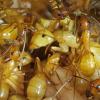Firstly, congrats on starting ant-keeping! It's really fun, ant (oops, i mean and[heh heh]) it provides you with plenty of pets like no other.
Some good beginner genera to consider are:
Camponotus Pros: (Large size (usually) for easy and hassle-free detailed observation, polymorphic (meaning that there are different castes of workers [ie. minor, media, major, supermajor... etc], usually not picky eaters (my C. Pennsylvanicus love almost everything i've fed to them) accept a nice range of conditions (heat, humidity, etc...) and are not fussy, and there are so many different species of Camponotus it's amazing, so you're bound to find one or two different ones.)
Cons: (Due to large size, colonies grow slowly. Usually, it takes about 1 month for an ant to grow from egg to worker, with these guys it takes around 2 to 2.6 months [highly dependent on species], your parents won't be happy if they escape, as Camponotus are carpenter ants and sometimes tunnel in the wood of a person's home)
Tetramorium Pros: (Very quick growth rate and very productive queens, enjoy a wide range of conditions, very hardy, eat a wide variety of foods. These are pavement ants, the ones you see on the sidewalk or in your school eating an old apple or stale bread so happily)
Cons: (Pretty small, monomorphic (only one caste of workers))
There are plenty others, crematogaster, formica, etc.. (as other members suggested). But these are my top two favorite colonies that I have. I hope this helped
Edited by Enthusiastic_Callow, April 22 2019 - 10:45 AM.
Colonies: (Max 60/70 workers)
Camponotus Pennsylvanicus
Lasius sp.
Prenolepis Imparis?
Tetramorium Immigrans x 2
Queens:
Lasius sp. (Different species than one above, caught recently)
- Not a lot of ants, I know. I don't look for queens anymore, I just stumble upon them (not literally). It's all an amazing learning experience for me! (I still take good care of them, don't worry). But I'm still as busy as an ant! 
![]()
![]()




















